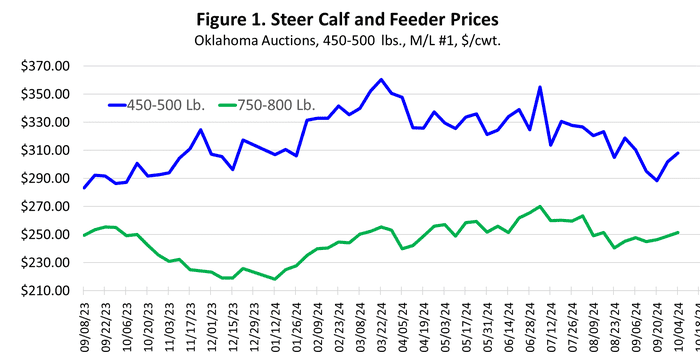Derrell Peel: Fall cattle market update
Posted on October 7, 2024
Source: Farm Progress. The original article is posted here.

Drought conditions continue to advance in Oklahoma, following the La Niña forecast that meteorologists have been suggesting for about a year. The latest Seasonal Drought Outlook, issued by the Climate Prediction Center, suggests that drought will persist and expand in the central and southern plains for the remainder of the year.
Forage production is mostly done for this growing season (with the exception of winter wheat) so dry conditions are not an immediate threat to forage pasture and range. Oklahoma hay supplies are quite large for the winter. However, water supplies may become a significant concern in the coming months. Many ponds are already low and typically do not recharge much in the fall and winter.
Winter wheat
Winter wheat planting is running behind schedule due to the dry conditions. At the end of September, wheat planting in Oklahoma was 22 percent, compared to a 32 percent average for the previous five years. Some wheat has been “dusted in” to dry soil to await moisture. Some wheat is up but stands are small and not growing much due to the lack of moisture. Opportunities for wheat grazing are slipping aways quickly.
Fall sales
The fall run of feeder cattle has started in Oklahoma. While the total auction volume of feeder cattle is down 9.2 percent year over year thus far in 2024, the auction volume of feeder cattle has been larger by 12.9 percent year over year since Labor Day. In early October, the auction volume included calves as well as big feeder cattle from summer grazing programs. It is possible that drought conditions and deteriorating pastures is resulting in earlier-than-planned marketings of calves and feeder cattle.
Related: Don’t rely on technology, learn the way to a profit
Calf markets
Feeder cattle prices continue to climb back from the August stock market and futures market corrections. Oklahoma auction prices for calves and feeder cattle have increased recently (Figure 1). For the calves, this is a counter-seasonal move as calves typically move lower through October into November. However, limited cattle numbers may continue to push feeder prices higher despite the lack of stocker demand this fall.

Cull cow prices remain above year ago levels but did drop in September. Cull cow prices typically decrease to a seasonal low in October/November. However, boning cow prices increased counter-seasonally in the first week of October. The volume of cull cows in Oklahoma auctions in 2024 is down 32.5 percent year over year, consistent with the 16.4 percent year to date decrease in beef cow slaughter thus far this year. The reduced inventory of cows likely means that seasonal cull cow price pressure this fall will be less than usual.

.jpg?disable=upscale&width=1200&height=630&fit=crop)


